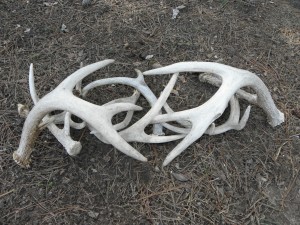Hunting Shed Antlers
By Glen Wunderlich
One of the most curious acts of nature involves antler growth. As most deer hunters know, antlers become an annual phenomenon by sprouting each spring and maturing during the summer months. The bony growth is used by deer to signal dominance and to ward off challengers. And, if a lesser buck doesn’t understand the significance of numerous, long antler tines and starts shoving his weight around, he’ll get the point. Yet, not unlike the leaves on a deciduous tree, the magnificent, coveted headgear falls to the ground just in time for the process to begin anew.
Hunting for sheds this time of year is a great way to break the monotony of the off season for a hunter or the entire family. It can be good exercise, while providing some of the motivation to get out and do something productive. It’s also a means to minimize the possibility of getting flat tires on tractors or other off-road vehicles before venturing out to work the food-plot ground. And, that brings me to the best place to find antler sheds: around food.
Food plots attract deer, but especially so during late season and afterward. Cash crops have been cashed in and by late winter browse becomes scarce. The effect is a concentration of deer in relatively small areas, giving shed hunters better odds with less time afield. In any event, if you’ve seen deer in a particular area routinely during winter, that would be a wise place to begin your own treasure hunt. Another area to inspect – again, where deer congregate – is bedding areas in and around conifer stands. It may not be as productive as food sites, but antlers are easily spotted atop pine straw in the sparse understory of dense canopies, where deer seek shelter from harsh winter weather.
Finding the bones can be problematic, if prospectors are looking for entire antler racks for 2 reasons: Antlers are cast in halves, typically in separate locations. Secondly, they can be camouflaged by vegetation, leaves, or branches. Much like attempting to see deer in heavy cover, hunters look for telltale indicators of a deer’s horizontal back line, or other seemingly insignificant portions of an animal that stand out against cover. The same logic applies to finding sheds by focusing on small, white colorations that don’t fit in, rather than some massive prize.
Using an ATV to cover more ground makes sense, as long as the speed is kept down. I like to stand on the foot pegs at times helping to gain an advantage of perspective. Binoculars can also help to cover ground with less effort, but it’s important to pan slowly, as well.
Michigan’s deer herd faces many challenges of survival with the onset of various diseases, an increase in predators and ever-shrinking habitat. Although sheer numbers are down widely, the age and quality of deer remaining has grown steadily over the past few years. And, if you want to get fired up about next year’s prospects for bagging a buck, there’s no better time than now to begin your search for evidence that a given bruiser has made it through another season.







